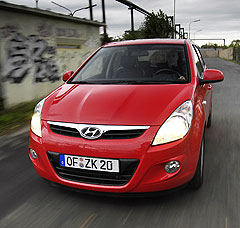Hyundai minis lost in translation
BY PHILIP LORD | 24th Jul 2009

Hyundai still hopes to get the cars here towards the end of the year, but Hyundai sales and marketing director Kevin McCann says: “That is becoming something quite hard to achieve.
“The i10 and i20 are built up from primarily Korean parts in the factory in India, making it difficult to set an exchange rate, and as there is no viable direct shipping available from India to Australia, costly shipping via a third country might have to be taken.
“There’s a lot of movements on the cross-rates, so we’re trying to find the right formulation to position the FOB [free on board] pricing at. So it’s a three-way negotiation rather than the normal two-way.”Mr McCann said there was no direct shipping route for roll-on, roll-off vehicle transport from India to Australia.
He said Hyundai would have to tranship via another port for at least the first few months, at extra cost.

Two other manufacturers already do this. Mahindra ships Australia's first Indian-built vehicle, the Pik-Up utility, via Singapore or Hong Kong, while Australia's first Indian-built passenger car, the new Suzuki Alto sub-light hatchback launched just this week, comes via Singapore.
Mr McCann said Hyundai had to decide if it would incorporate the transhipment cost burden into the car, “depending on how we see the future of the car and our ability to convert to direct shipping at a later stage in the life cycle”.
“The ship’s going to have to go from India to perhaps, for example Korea, where the ships are going back to, and then unload the cars on a wharf there and reload the cars on a ship that’s coming down to Australia, full of other cars.
“A back-loaded ship is normally empty, so it doesn’t normally have the same factor as the normal shipping but there’s still a cost involved in loading and unloading.”With such sensitive pricing in the sub-light and light car market, Hyundai wants to get off on the right foot with what it considers vital cars for its future.
“The decision we face is, do we take a hit up front, and anticipate we’re going to have a lower cost in the near future, or do we pass it on up front because we know it’s never going to change,” Mr McCann said.
“We have to decide for how long does it have to be that way before volume is sufficient for us – perhaps not to fill ships – but sufficient for them to make a voyage from India to Australia.”While a Hyundai Australia team arrived back this week from negotiations with head office in Korea, Mr McCann says he doesn’t know the outcome as yet and suspects there will be no resolution just yet to the impasse.
“They’ve only got back this morning, and we haven’t got our heads together, so I don’t know at this stage [and even if known] that doesn’t necessarily mean that we’ll come to a decision in the next few days.
“It’s just a matter of passing to another stage of the discussion. I don’t know how far along that takes us in terms of the progress we have to make.”